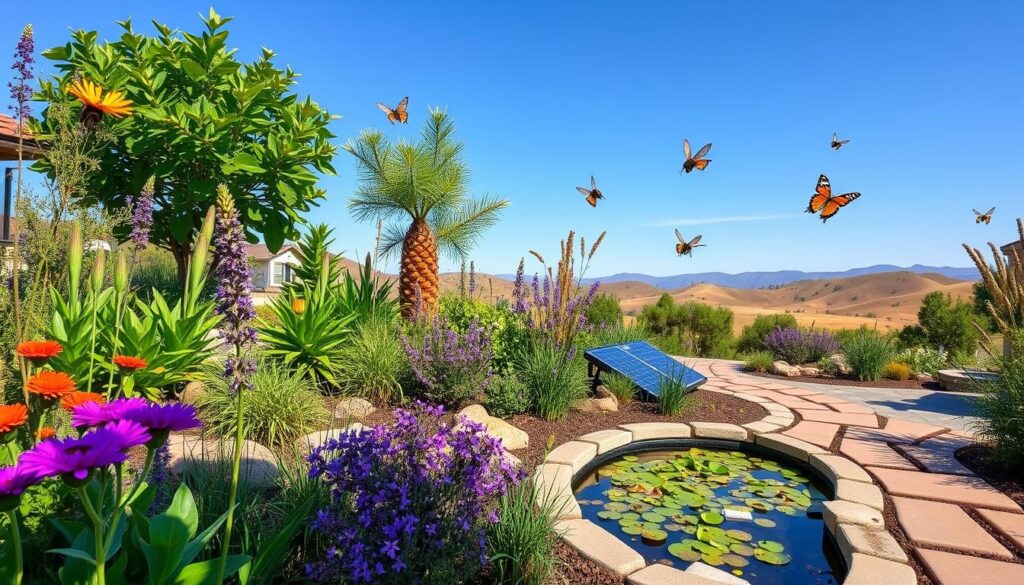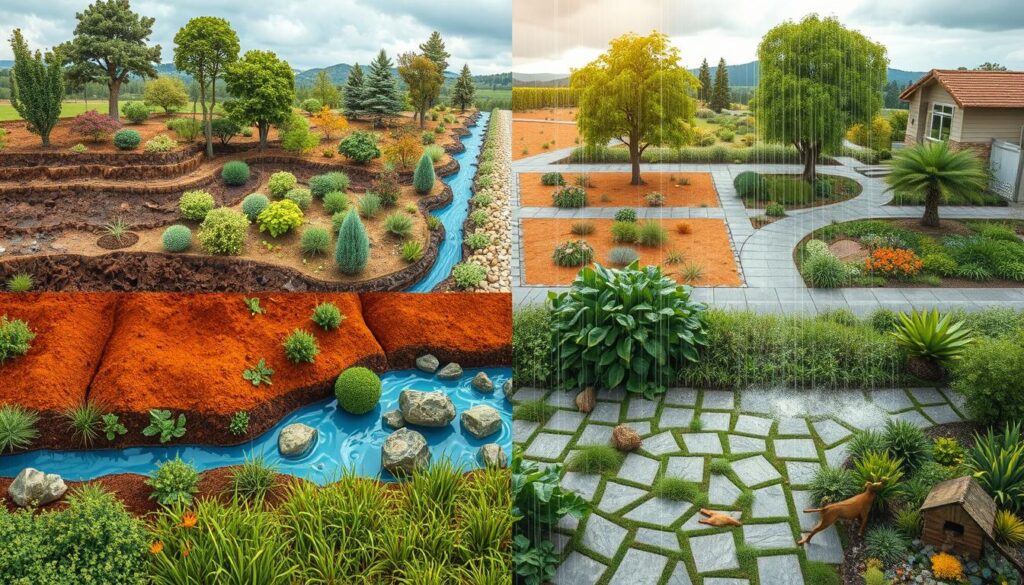
Landscape design and construction have long affected our environment. As we face more ecological challenges, it’s vital to use sustainable landscaping. This article looks at eco-friendly design and green practices to lessen environmental harm.
Traditional landscaping often ignores the need to protect the environment. By choosing sustainable methods, we can make beautiful outdoor spaces that respect nature. We can save water and manage soil better, reducing our environmental impact.
Choosing eco-friendly landscaping design is not just a trend; it’s essential for saving our planet. By using green practices, we help the environment while creating beautiful outdoor areas that last for years.
Key Takeaways
- Sustainable landscaping reduces negative environmental impacts
- Eco-friendly design works in harmony with nature
- Water conservation is crucial in landscape projects
- Green practices contribute to long-term environmental health
- Thoughtful design can create beautiful and sustainable outdoor spaces
Understanding Environmental Challenges in Landscaping

Traditional landscaping often has hidden costs to our environment. It can lead to water waste, soil erosion, and harm ecosystems. Let’s look at these issues and why we need sustainable solutions.
Environmental Issues in Traditional Landscaping
Many traditional landscaping methods harm the environment:
- Water waste through inefficient irrigation
- Soil erosion from poor land management
- Habitat destruction due to non-native plant use
- Chemical pollution from excessive fertilizer and pesticide use
- Biodiversity loss caused by monoculture lawns
Importance of Sustainable Practices
Sustainable landscaping tries to reduce these negative impacts. It uses native plants, reduces water use, and avoids harmful chemicals. This way, we can create beautiful outdoor spaces that help local ecosystems.
Benefits of Eco-Friendly Landscape Design

Choosing sustainable landscaping has many benefits:
- Lower maintenance costs
- Improved soil health
- Enhanced property value
- Reduced carbon footprint
- Increased biodiversity in urban areas
By understanding these challenges and choosing eco-friendly options, we can make beautiful and good landscapes for the planet. This ensures our outdoor spaces help our planet’s health. Immerse yourself in this captivating article.
Sustainable Landscape Design Construction: Key Principles
Sustainable landscape design makes outdoor spaces beautiful and eco-friendly. It uses ecological design to blend with nature.
Low-impact development is key in sustainable landscaping. It aims to disturb nature as little as possible. When planning, keep these principles in mind:
- Work with natural topography
- Preserve native vegetation
- Protect local wildlife habitats
- Reduce soil erosion
Resource efficiency is crucial in sustainable landscaping. Use local materials to reduce emissions, and add recycled or repurposed items to reduce waste.
Climate-responsive landscaping strengthens outdoor spaces. Pick plants that do well in your area and need little care. Group plants by water need to save water.
These principles help create landscapes that are not only pretty but also good for the planet. Sustainable design saves resources, supports local life, and creates spaces for future generations to enjoy.

Water Conservation Strategies for Landscape Projects
Water conservation is key in today’s landscaping. Smart designs can make outdoor spaces beautiful while saving water. Let’s look at ways to achieve this balance.
Efficient Irrigation Systems
Smart irrigation systems are a big step forward in saving water. They use weather data and soil sensors to water plants when needed. Drip irrigation sends water straight to the roots, cutting down on waste.
Programmable timers make sure water is used during cooler hours. This reduces evaporation and saves more water.
Drought-Tolerant Plant Selection
Xeriscaping uses plants that don’t need much water. Native plants are already adapted to the local climate and use less water. Succulents, lavender, and ornamental grasses are great for water-saving gardens.
Grouping plants with similar water needs helps with watering. This makes irrigation more efficient.
Rainwater Harvesting Techniques
Collecting rainwater is a green way to help with irrigation. Rain barrels catch roof runoff, giving free water for gardens. Greywater systems use household water for the garden.
Permeable surfaces like porous pavement let rainwater soak into the ground. This reduces runoff and helps groundwater.
- Install rain gardens to capture and filter stormwater
- Use rain chains to guide water from gutters to collection points
- Create bioswales to manage water flow in larger landscapes
By using these strategies, you can make a water-saving landscape. It will be both beautiful and sustainable. Smart irrigation, xeriscaping, and new water management systems help save water.
Soil Management and Erosion Control
Healthy soil is essential for sustainable landscapes. Adding organic matter improves soil health, creating thriving ecosystems. Landscapers can boost soil quality with compost, leaf mold, and natural amendments.
These additions increase nutrient content and water retention. This helps plants grow strong and healthy.
Erosion prevention is key for stable landscapes. Mulching protects the soil and saves moisture. Planting deep-rooted native species anchors soil and stops runoff.
These methods keep soil structure intact and boost ecosystem health.
Managing stormwater is crucial in sustainable landscaping. Bioretention systems, like rain gardens, capture and filter runoff. This reduces pollution and recharges groundwater.
Permeable paving lets water seep through, reducing runoff. These methods help mimic natural water cycles, making urban environments healthier.
Landscapers create eco-friendly spaces by focusing on soil health, erosion control, and smart water management. These efforts improve the landscape and help the environment.
FAQ
Q: What are some common environmental issues in traditional landscaping?
A: Traditional landscaping can waste a lot of water and cause soil erosion. It also harms habitats and pollutes the environment with chemicals, harming the ecosystem and our planet.
Q: Why are sustainable landscaping practices important?
A: Sustainable landscaping helps fix the problems caused by old methods. It saves natural resources, cuts down on pollution, and supports biodiversity, making landscapes better for the environment and more durable.
Q: What are some key principles of sustainable landscape design and construction?
A: Sustainable landscaping focuses on ecological design and low-impact development. It aims to be resource-efficient and climate-responsive. This means working with nature, causing less disturbance, and using energy wisely.
Q: How can water conservation be achieved in landscape projects?
A: To save water in landscapes, use efficient irrigation and drought-resistant plants. Rainwater harvesting and permeable surfaces are also key. These methods reduce water waste and better manage water.
Q: Why are soil management and erosion control important in sustainable landscaping?
A: Good soil management and erosion control keep soil healthy and stable. Practices like improving soil, mulching, and using bioretention prevent erosion. They also help plants grow well.
Yavapai Landscaping Prescott offers no-cost estimates for its landscaping and tree services in Prescott and the neighboring regions. These include tree elimination, pruning, stump grinding, land clearance, storm clean-up, and emergency tree care.
